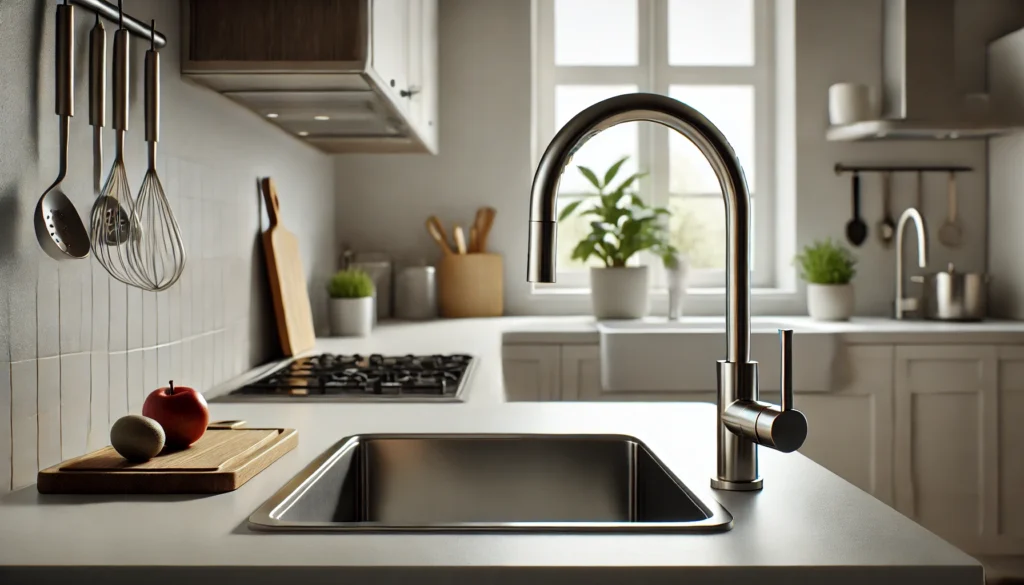At first glance, the Sink size of a kitchen faucet may seem inconsequential, a mere detail in the grander scheme of kitchen design. Yet, its significance runs deeper, influencing both the functionality and the visual harmony of your space. A faucet too large can overshadow a small sink, creating an awkward, overbearing presence. Conversely, a diminutive faucets can leave a larger basin underutilized, straining its practical value. It’s a delicate balance—one that many fail to strike, often prioritizing aesthetic appeal or brand prestige over size compatibility. The fallout from such decisions? Inconvenience, inefficiency, and the inevitability of a costly replacement.
Understanding Faucet Size: What Does It Mean?
Faucet size is not merely a matter of physical dimensions; it encompasses a range of functional metrics. Height, for instance, determines how much clearance exists between the faucet and the sink, critical when washing bulky pots. Reach refers to the extent of the spout, dictating where the water lands in the basin. Installation holes also factor in, guiding how and where the faucets attach. A faucets size, then, is not just about appearance. It’s about ensuring that every drip of water lands where it’s supposed to, with maximum efficiency.
Different Types of Kitchen Faucets
The world of kitchen faucets is far from monolithic. You have the simplicity of a single-handle faucet, a clean and minimalist design that allows for swift, one-handed adjustments. Then there’s the precision of the double-handle tube, offering fine-tuned temperature control with separate knobs for hot and cold. Pull-down faucets? Their height and dramatic arc make them perfect for filling deep pots, while pull-out models provide versatility, ideal for compact spaces. The size of each varies, and choosing without understanding how size impacts function could leave you with a faucets that simply doesn’t meet your needs.
How to Measure Your Kitchen Sink for the Right Faucet?
Before purchasing a tube, take a tape measure and become familiar with your sink’s dimensions. Begin by measuring the distance between the center of the sink and the backsplash—this will prevent a clash between faucet and wall. Next, assess the depth of the basin, as this will determine the optimal tube height. Deeper sinks may require taller faucets for ease of use. The width is also crucial; ensure the faucet’s reach extends to all corners of the sink. Finally, check how many installation holes are available—whether one or three will guide your faucets selection.
Matching Faucet Size to Sink Size: A Simple Guide
The art of pairing faucet size with sink dimensions lies in balance. For grand, sprawling sinks, opt for a faucets with extended reach and substantial height, ensuring the water flows efficiently across the basin. Mid-sized sinks demand a more modest solution, perhaps a faucet with a medium reach and arc. And for the small sinks of cozy kitchens, a compact faucets with a shorter spout is not only practical but keeps the aesthetic cohesive. The trick is ensuring water reaches all areas without excessive splashing, allowing for both functionality and ease of use.
Understanding Standard Faucet Sizes
Most kitchen faucets fall into a standard size range, which simplifies the decision-making process. Typically, faucets stand between 8 to 12 inches in height, with a spout reach extending around 8 to 10 inches. These dimensions cater to the average sink, ensuring that water delivery is neither too far nor too close. Still, some kitchens—those with unusually deep or shallow sinks—may demand deviations from these norms. Understanding these typical measurements helps narrow down choices, aligning your sink’s needs with available options.
Customizing Faucet Size for Unique Sink Designs
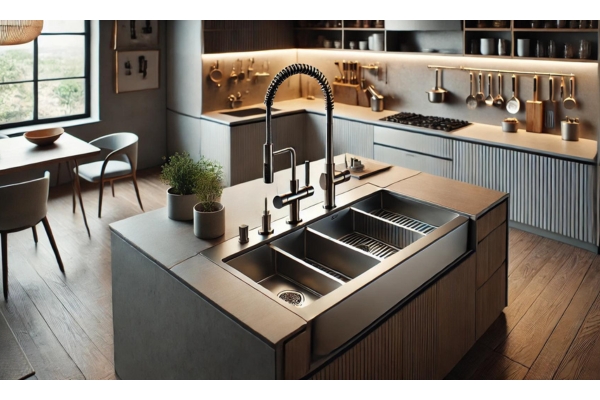
Of course, not all sinks fit within the realm of “standard.” Custom or uniquely designed basins require a more tailored approach. A deep basin, for instance, may call for a towering faucet to prevent splashing and enhance usability. Multi-basin sinks present their own challenges, often requiring a tube with a longer reach or a swiveling spout to accommodate both sides. Flexibility is key in such setups, ensuring that each part of the sink receives adequate water flow, no matter how unconventional the design.
Importance of Faucet Reach: Why It Matters for Your Sink
The reach of your faucet is more important than it might initially seem. If the spout fails to extend far enough, water may splatter awkwardly or fail to hit the center of the basin, resulting in constant cleanup. For larger sinks, a spout with a reach of 10 inches or more ensures water distribution across the entire sink. Smaller basins can manage with shorter spouts, but balance is always key. Matching the reach of the faucets to the sink dimensions is essential in creating a space that is both functional and efficient.
Choosing The Right Faucet Height for Your Kitchen Sink
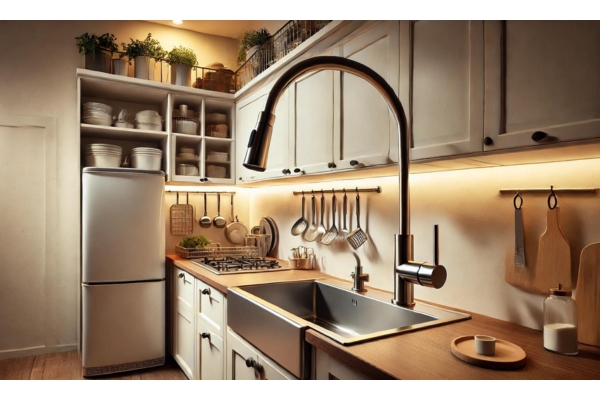
A faucet’s height determines much more than just its silhouette. Taller faucets, reaching above 10 inches, provide ample clearance for filling large pots or rinsing oversized trays. But in kitchens with limited overhead space—those with low-hanging cabinets, for example—a shorter faucets might be more practical. The height should allow you to comfortably use the sink without feeling cramped, while still accommodating the full range of kitchen tasks.
Single vs. Double Handle Faucets: Does Size Differ
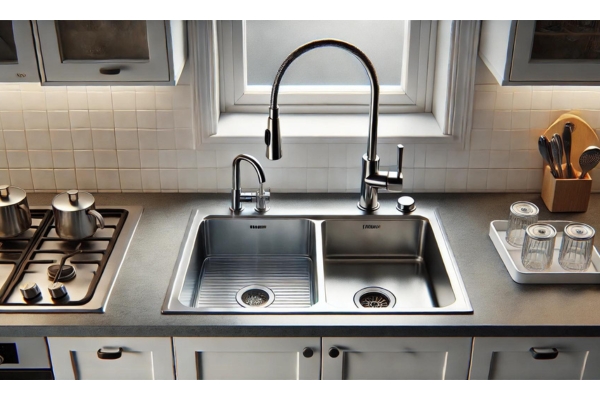
Single-handle faucets are a compact choice, often requiring minimal space and offering seamless installation. Their sleek design generally means a more streamlined appearance, ideal for smaller kitchens. Double-handle faucets, by contrast, take up more room, with their separate controls for hot and cold water. This not only affects the width of the installation but may also dictate the number of holes needed in your sink or countertop. Though both styles can be adapted to fit most kitchens, the space they occupy is a crucial factor in choosing the right size.
Pull-Down vs. Pull-Out Faucets: Size Differences to Consider
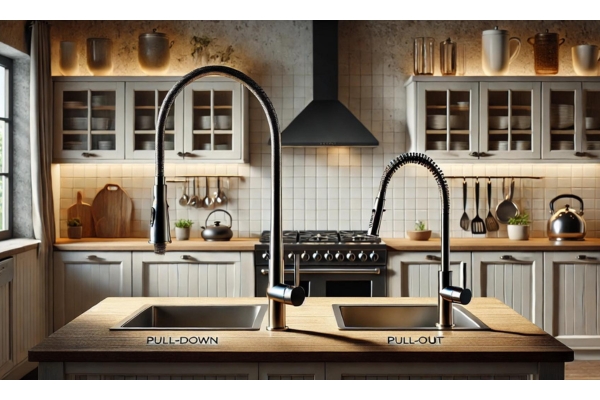
While similar in function, pull-down and pull-out faucets differ dramatically in size. Pull-down faucets tend to be taller, with a pronounced arc that allows for maximum clearance. They’re ideal for deep sinks or kitchens where large cookware is frequently used. Pull-out faucets, meanwhile, are more compact and suited for small spaces. Their shorter spout and flexible hose offer versatility without requiring significant height or reach. The choice between these two depends largely on your kitchen layout and sink size.
Faucet Size and Counter Space: How They Affect Each Other
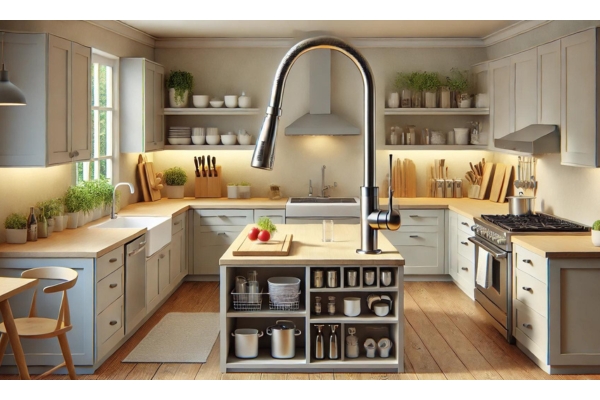
The relationship between faucet size and available counter space can be unexpectedly intertwined. Larger faucets, with their extended reach and towering heights, can encroach on valuable countertop real estate, especially in compact kitchens. Meanwhile, smaller faucets allow for greater freedom, maximizing workspace while maintaining functionality. Achieving balance between a faucets size and the space surrounding it is vital, particularly when kitchen surfaces are at a premium.
How Faucet Mounting Style Affects Faucet Size?
The style of faucet mounting—whether deck-mounted, sink-mounted, or wall-mounted—affects size considerations. Wall-mounted faucets, for example, often need longer spouts to reach the sink, given the additional distance from the basin. Deck-mounted faucets, in contrast, sit closer to the sink’s edge, potentially requiring less reach. Each mounting option brings its own set of dimensions, so choosing the right one will depend on your kitchen’s specific setup.
Choosing The Right Spout Height and Arc for Your Kitchen Faucet
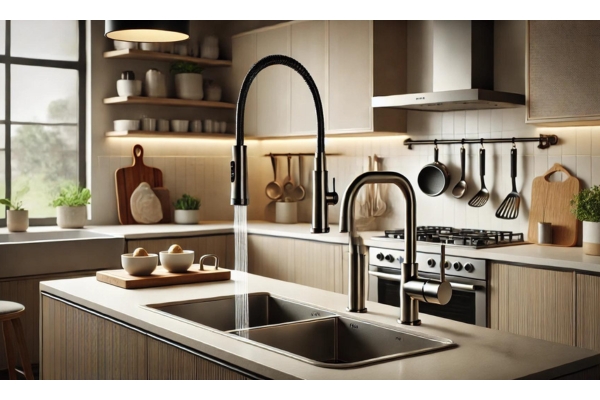
The spout height and arc shape directly impact both the aesthetics and practicality of your kitchen faucet. A high-arc tube, rising dramatically above the sink, is perfect for kitchens where large cookware and deep basins are the norm. On the other hand, low-arc designs are more understated, providing just enough clearance for everyday tasks without dominating the space. Matching the spout’s arc to the type of kitchen tasks you undertake is a crucial step in ensuring that your faucets function smoothly in your day-to-day routine.
Faucet Size for Farmhouse and Apron Sinks
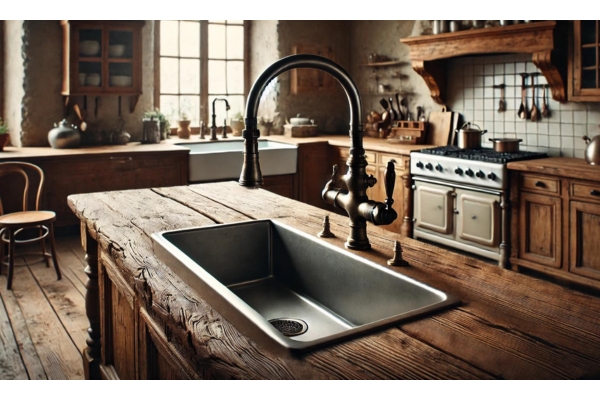
Farmhouse and apron sinks demand faucets with a more substantial presence. Their wide, deep basins pair beautifully with taller, more robust faucets, allowing for easy use in larger spaces. These traditional sinks, often seen as the heart of rustic kitchen designs, require faucets that not only fit their size but complement their timeless aesthetic. A small or delicate tube would feel out of place in such a bold environment.
Faucet Size Considerations for Undermount Sinks
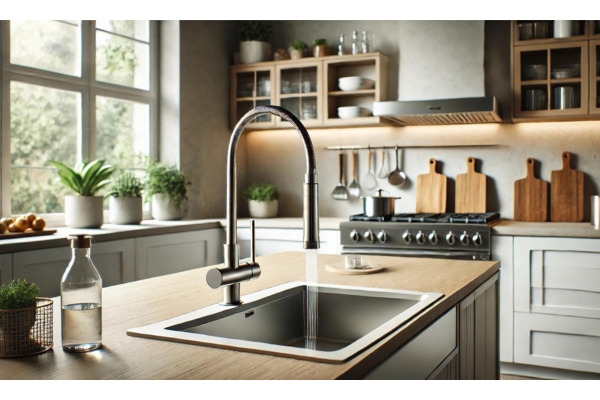
Undermount sinks present unique challenges when it comes to selecting tube size. Since these sinks are installed beneath the countertop, there’s a lack of visible edges to catch water splashes. This means that tube height and reach need to be carefully calculated. A faucet that’s too short or lacks proper reach can lead to frequent splashing on countertops, while a well-sized tube can prevent these annoyances and make daily tasks far smoother.
How Sink Material Affects Faucet Size Choice?
The material of your sink should not be overlooked when choosing faucet size. Stainless steel sinks often look best paired with sleek, modern faucets that mirror their simplicity and industrial feel. Cast iron or granite sinks, however, are more substantial and may require a more robust tube to match their weight and texture. A tube that complements the sink material ensures a harmonious look, tying the entire kitchen together both functionally and aesthetically.
Budget Considerations When Choosing Faucet Size
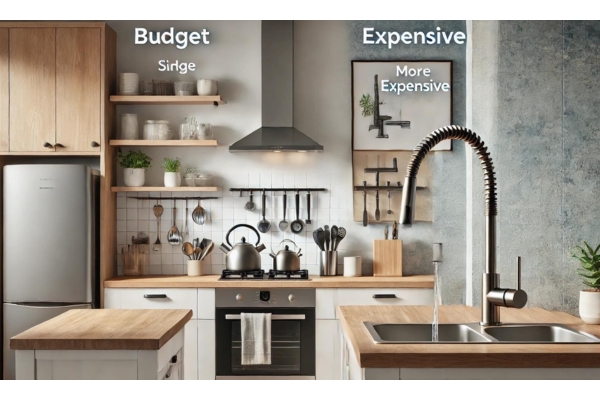
While larger faucets or those equipped with specialized features might come with a higher price tag, there are budget-friendly options that offer great functionality without overspending. Knowing what features are absolutely necessary versus those that are simply nice to have can help guide your choices. Allocate your budget thoughtfully to ensure you get a tube that suits your kitchen needs, without sacrificing size or usability.
Secondary Factors To Consider When Choosing Faucet Size
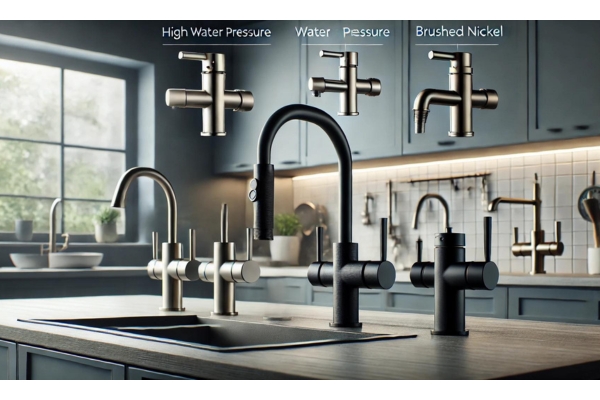
Beyond the obvious metrics of height and reach, there are other factors—like water pressure and finishes—that influence faucet size. High water pressure, for example, may require a more durable tube to handle the force, while finishes like matte black or brushed nickel can affect the overall aesthetic balance. These secondary considerations, though not directly linked to size, impact the overall functionality and appeal of your faucet.
Mistakes To Avoid When Selecting the Size Faucet For Kitchen Sink
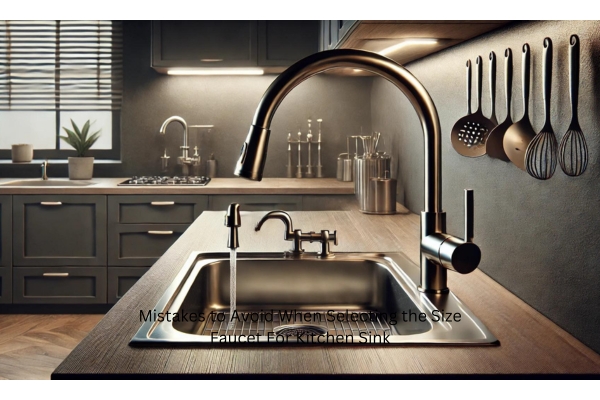
Choosing the wrong faucet size can lead to myriad issues, from improper water flow to an uncomfortable user experience. One common mistake is selecting a tube based purely on looks, without considering whether its size is compatible with the sink. Ensuring that the faucet aligns with both the sink’s dimensions and the kitchen’s overall design will help you avoid these costly errors.
Conclusion
Finding the right faucet size is no small feat, but with careful attention to factors like height, reach, and mounting style, it’s possible to achieve the perfect balance. By taking the time to measure your sink and understand its needs, you can select a tube that not only enhances the kitchen’s functionality but also complements its aesthetic beauty.
